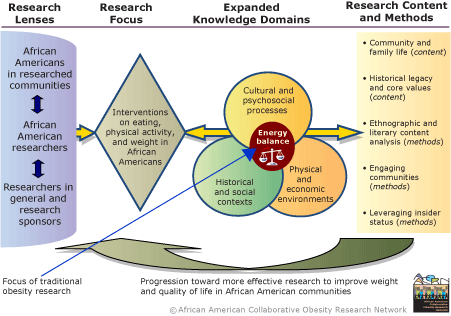

|

|

Volume 4: No.
4, October 2007
TOOLS AND TECHNIQUES
Expanding the Obesity Research Paradigm
to Reach African American Communities

This figure is a process chart consisting of four major headings arranged horizontally across the top of the figure with graphic elements under each heading. The headings read from left to right as follows: “Research Lenses,” “Research Focus,” “Expanded Knowledge Domains,” and “Research Content and Methods.”
The graphic element under the heading on the far left of the figure, “Research Lenses,” is a cylinder that contains a list of three categories: “African Americans in researched communities,” “African American researchers,” and “Researchers in general and research sponsors.” These categories are arranged vertically and with two-way arrows between
them.
The graphic element under the second heading from the left, “Research Focus,” is a diamond shape that contains the words, “Interventions on eating, physical activity, and weight in African Americans.” A one-way arrow flows from the column of the first heading, “Research Lenses,” to this diamond graphic.
The graphic element that appears under the third heading is a Venn diagram type grouping of three large circles with a small circle at their intersection. The topmost of the large circles is labeled “cultural and psychosocial processes.” The lower circle on the left is labeled “Historical and social contexts,” and the circle on the right is labeled “Physical and
economic environments.” The small circle at the center of these three intersecting circles is labeled “Energy balance” and has a small drawing of a balance scale within it. A label in the margin connects to this small circle and is labeled “focus of traditional obesity research.” One-way arrows flow out from both the left and the right of this circle graphic
connecting it to the diamond-shaped graphic to its left, “interventions on eating, physical activity, and weight in African Americans,” and to the final graphic element on its right.
The final graphic element on the right is a vertical rectangle with the heading of “Research Content and Methods” that lists five bulleted items: “Community and family life (content),” “Historical legacy and core values (content),” “Ethnographic and literary content analysis (methods),” “Engaging communities (methods),” and
“Leveraging insider status (methods).”
At the bottom of the figure a large, one-way arrow flows from the rectangle labeled “Research Content and Methods” back to the first graphic, the column labeled “Research Lenses.” Under this bottom arrow is the caption, “Progression toward more effective research to improve weight and quality of life in African American communities.”
Figure: AACORN’s Expanded Obesity Research Paradigm.
Reprinted with permission of the African American Collaborative
Obesity Research Network.
This paradigm expansion is based on the premise that the behaviors that determine weight status are embedded in the core social and cultural processes and environments of day-to-day life. Therefore, identifying effective solutions to obesity requires an ecological model that is inclusive of relevant contextual variables, which include variables influenced by race,
ethnicity, and social position. Center: The traditional focus on caloric intake and output is depicted in the intersection of knowledge domains potentially informative for developing interventions on eating, physical activity, and weight. This representation conveys the utility of factoring in knowledge of historical and social contexts, cultural and psychosocial processes, and the
physical and economic environments that influence preferences, perceived and actual choices related to food and activity, and the relative ease or difficulty of exercising these choices. Such knowledge is fundamental to understanding the perspectives and day-to-day experiences that are the backdrop for weight control efforts. Accessing relevant knowledge from these expanded domains is enhanced by
interactions with scholars in fields such as family sociology, literature, philosophy, transcultural psychology, economics, marketing, and urban planning. Left: What is seen, asked, and heard depends on who is looking and listening. Important eyes and ears for understanding weight issues include those of lay members of the communities of interest (e.g., African Americans in
researched communities) and researchers in relevant fields whose expertise incorporates insights based on lived experiences and shared identity with the community of interest (e.g., African American researchers in nutrition, physical activity, public health, and other areas), in addition to other researchers with relevant interests and expertise, and research sponsors. Right:
Content and methodological themes emanating from this inclusive, integrative paradigm applied to African Americans highlight 1) the importance of considering family and community interactions related to food acquisition, food- and activity-related social interactions, the structure and organization of community processes, women’s roles, and differences by generation, social position, and
other demographic variables; 2) the potential influence of the collective historical legacy of slavery and its derivatives on core values such as trust and loyalty and on interactions with the health care system, media, and other social institutions; 3) the potential value of qualitative investigations that include direct observations, eliciting and analyzing narratives, and exploring the content
of literary expressions to yield different or richer insights than obtained from more typical biomedical approaches; 4) the essential need to fully incorporate the views, expertise, and agency of community partners in the research process; and 5) the potential benefits and challenges of encouraging African American researchers to leverage their insider status in ways that benefit the communities
they study, the research endeavor, and their own academic careers.
Return to article
|
|
